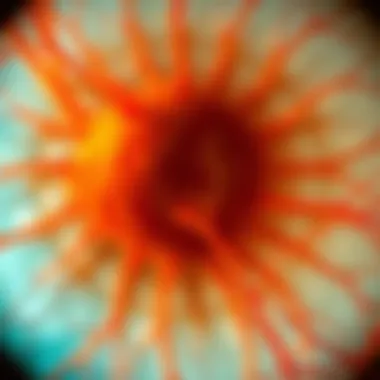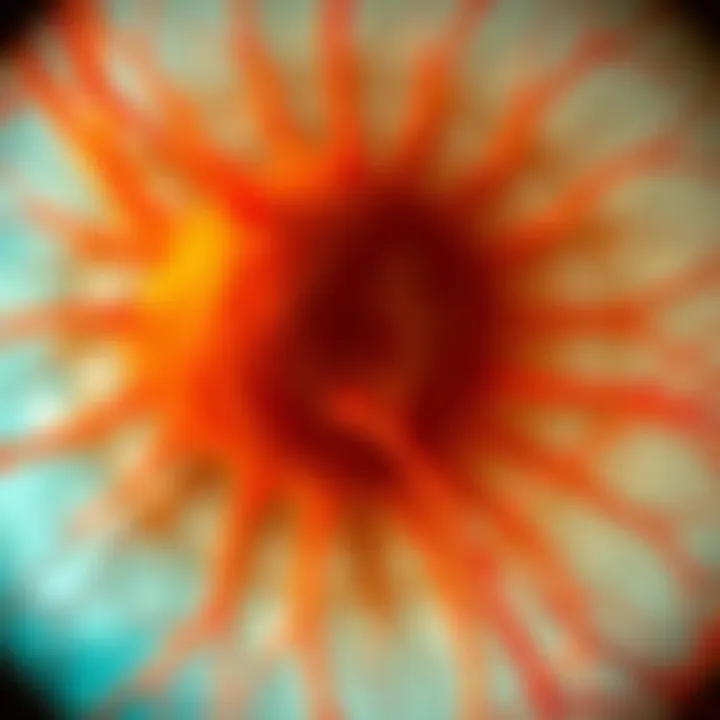Understanding Diabetic Retinal Neuropathy: Insights and Impacts


Intro
Diabetic retinal neuropathy is an often-overlooked facet of diabetes mellitus that can significantly impact a person's visual health and quality of life. The intricacies of this condition are profound, affecting not only the eyes but also intertwining with broader health concerns associated with prolonged diabetes. This article intends to dissect the layers of diabetic retinal neuropathy, shedding light on its underlying mechanisms, risk factors, diagnostic strategies, and management tactics.
Glancing through the research literature, one may find varying opinions concerning its prevalence and severity. Many individuals, even those living with diabetes for decades, may be unaware of this complication until severe symptoms arise. Here's a sobering fact: Diabetic retinal neuropathy is not just a technical term; it's a reality that could alter a person's life trajectory. Nowadays, as diabetes continues to affect millions globally, understanding this condition becomes paramount for healthcare professionals and patients alike.
Through this exploration, we aim to foster deeper awareness while also equipping readers with the knowledge necessary to advocate for themselves or their patients more effectively. Whether you’re a student diving into research, a seasoned educator imparting knowledge, or a healthcare professional on the front lines, the insights offered here are designed to resonate and provoke thoughtful discussion.
Foreword to Diabetic Retinal Neuropathy
Diabetic retinal neuropathy is a serious consequence of diabetes that many may overlook. It’s critical we understand this condition, as it can significantly affect the quality of life for those with diabetes. Unlike other diabetes-related complications, this issue specifically targets vision and often creeps in unnoticed, making awareness salvation.
The importance of this introduction lies in its potential to drive comprehension and ultimately prompt proactive care among practitioners and patients alike. By shedding light on the definition and prevalence, we endeavor to compile a thorough background that addresses both the individuals living with this illness and the healthcare providers tasked with their care.
Definition
Diabetic retinal neuropathy can be defined as damage to the retinal nerve fibers arising from long-standing diabetes mellitus. The high levels of glucose in the blood can create a toxic environment, leading to the deterioration of critical nerve pathways in the eye. This condition goes beyond just a simple vision issue; it can result in severe complications if not properly managed. Although not entirely understood in all aspects, early identification and management are crucial for preserving vision.
Prevalence
The prevalence of diabetic retinal neuropathy is a concern that cannot be brushed aside. The statistics are staggering. Approximately 30% of individuals with diabetes will develop some form of diabetic retinopathy during their lifetime. When you narrow it down to those who have had diabetes for over twenty years, this figure can skyrocket to about 80%. These numbers paint a concerning picture, highlighting the necessity for regular eye examinations and screening procedures. Factors such as demographic variables, geographic location, and healthcare access also play an essential role in these statistics.
The World Health Organization estimates that the number of people living with diabetes will rise to 642 million by 2040, amplifying the need for awareness regarding diabetic retinal neuropathy.
Given the rising prevalence of diabetes globally, understanding diabetic retinal neuropathy has never been more vital. The effects are profound—not only on individuals but also on healthcare systems and society as a whole, making education and awareness essential in our approach to diabetes care.
Pathophysiology of Diabetic Retinal Neuropathy
Understanding the pathophysiology of diabetic retinal neuropathy is critical for grasping why the condition occurs and how it can be effectively managed. This section will explore the intricate mechanisms involved, which can be quite a puzzle but provide essential clues for treatment.
Neuropathic Mechanisms
The neuropathic mechanisms behind diabetic retinal neuropathy are a result of a complex interplay of factors arising from prolonged exposure to high glucose levels. One of the primary culprits is hyperglycemia; when blood sugar levels remain elevated, it leads to the accumulation of sorbitol and fructose through the action of the enzyme aldose reductase. This accumulation wreaks havoc on the retinal neuron structure, causing cellular stress and eventually leading to neuronal apoptosis or death.
Moreover, oxidative stress is a key feature of this degeneration. Excess glucose enhances the production of reactive oxygen species (ROS), which can damage retinal cells. This oxidative damage results in inflammatory responses that further compromise retinal health.
Often, patients may not even realize they are suffering from these cellular changes until the damage becomes significant, emphasizing the silent but ferocious nature of the disease.
An essential aspect to consider is that these neuropathic changes are not isolated to the retinal ganglion cells but extend to the inner nuclear layer of the retina as well. Patients can display symptoms such as blurred vision or reduced contrast sensitivity even when they feel perfectly healthy. This nuance in understanding neuropathic mechanisms highlights the importance of early screening and ongoing monitoring for individuals with diabetes to mitigate these changes effectively.
Vascular Changes
Vascular alterations significantly influence the severity and progression of diabetic retinal neuropathy. High blood sugar levels not only affect neurons but also provoke pathological changes in the retinal blood vessels. One prominent change is the increase in vascular permeability, which allows for the leakage of protein and fluids into the retinal layer. This puts individuals at a higher risk for developing diabetic macular edema—a serious condition that can significantly decrease vision.
Retinal ischemia also plays a crucial role here. The endothelial cells in the blood vessels become dysfunctional due to persistent hyperglycemia, leading to slowing down of blood flow. Insufficient oxygen supply to the inner retina compromises retinal integrity, and the oxygen-starved tissue could result in the proliferation of abnormal blood vessels, a condition known as proliferative diabetic retinopathy.
Both neuropathic and vascular changes work hand-in-hand, intensifying the impact on a patient's vision. It is a vicious cycle where the effects of one exacerbate the other, underscoring the complexity of managing diabetic retinal neuropathy.
For further reading on diabetic retinal neuropathy, refer to Wikipedia or Britannica.
Additionally, for a discussion on ongoing research in the field, you may find useful insights on platforms like Reddit or Facebook groups focused on diabetic health.
Risk Factors for Development
The significance of identifying the risk factors for diabetic retinal neuropathy extends far beyond mere awareness; it’s about understanding how these variables interact with diabetes and the potential for preventive measures. Recognizing these factors can enable healthcare professionals to implement proactive strategies to mitigate the risks associated with diabetic eye diseases. By addressing these risk factors, individuals may not only improve their ocular health but also their overall well-being, as the eyes often reflect general health conditions.
Diabetes Type and Duration
When it comes to diabetic retinal neuropathy, the type of diabetes plays a crucial role. Type 1 diabetes, typically diagnosed in younger individuals, involves the body's inability to produce insulin. Conversely, Type 2 diabetes, often seen in adulthood and linked to obesity, is characterized by insulin resistance. Research indicates that individuals with Type 1 diabetes face higher risks of developing neuropathy and related complications, particularly as the years roll by. The longer one has diabetes, particularly beyond 10 years, the more likely they are to see nerve damage, including in the eyes.
One might consider the statistics deeply alarming—nearly 90% of individuals with Type 1 diabetes may develop some form of retinopathy within 30 years of diagnosis, underscoring the importance of continuous monitoring and patient education. Understanding individual patient histories, including how long they have been living with diabetes, allows clinicians to tailor their recommendations and management plans accordingly.
Hypertension and Hyperlipidemia
Beyond diabetes itself, other medical conditions can intensify the risks of developing diabetic retinal neuropathy. Hypertension, which affects a significant population, can exacerbate the damage to retinal blood vessels, leading to complications. Poorly controlled blood pressure can cause strain on the delicate vascular structures in the retina, thereby increasing the risk of visual impairment.
Similarly, hyperlipidemia, characterized by elevated lipid levels in the blood, can result in a chain reaction that damages vascular integrity. Fat deposits can clog up small blood vessels and hinder circulation, not only in the heart and brain but also in the eyes. This association means that managing these conditions effectively could be a game-changer in preventing the onset of diabetic retinal issues. Individuals should be encouraged to monitor and manage their cholesterol levels and blood pressure, as these intertwined factors significantly affect overall health and vision.
Genetic Predisposition


Interestingly, while lifestyle factors like diet and exercise play a substantial role in diabetes management, genetics cannot be overlooked. Research suggests a genetic predisposition to diabetic complications, which might provide insights into why some individuals, despite similar levels of diabetes management, develop retinal neuropathy while others do not. Certain gene variants can affect how one’s body responds to insulin, amongst other metabolic processes tied to diabetes.
There is a clear need for more genetic research to understand this complex interplay. Healthcare professionals might consider incorporating genetic counseling for at-risk individuals. By understanding one's genetic risk factors, more personalized prevention strategies can be devised.
Investing time in understanding these risk factors not only enhances patient education but empowers individuals to take charge of their health decisions.
In summary, grasping these risk factors can dramatically influence how healthcare providers approach diabetic retinal neuropathy. The path from diabetes to potential vision loss is informed by the nuances of one’s unique circumstances, establishing a framework for proactive engagement in preventive care.
Clinical Manifestations
Understanding the clinical manifestations of diabetic retinal neuropathy is crucial for recognizing the disease's presence and evaluating its severity. Recognizing symptoms early can be pivotal in preventing potential complications and maintaining quality of life for patients. Accurate identification of signs aids healthcare professionals in navigating towards appropriate management strategies effectively while also empowering patients through knowledge of their condition.
Symptoms and Signs
Blurred Vision
Blurred vision is one of the first and most common symptoms associated with diabetic retinal neuropathy. Individuals may find that their sight isn't as sharp as it used to be, creating a haze over their visual perception. This symptom is significant because it often prompts individuals to seek medical advice, leading to earlier intervention. A key characteristic of blurred vision is its erratic nature; some may experience it consistently, while for others, it may fluctuate. The quality of vision impacts daily life vastly, from driving to reading. However, it's vital to note that blurred vision may also be a side effect of other factors like fluctuating blood sugar levels, creating a complex interplay that can confuse diagnosis.
Visual Field Loss
Visual field loss can occur gradually and is typically an insidious manifestation of diabetic retinal neuropathy. This condition may present itself as blind spots or areas in the visual field that seem unresponsive. The loss of visual fields poses significant risks for individuals, often affecting their ability to perform routine tasks safely. A distinguishing feature of visual field loss is that many might not perceive it until substantial damage has occurred, underscoring the importance of regular screenings for individuals at risk. This symptom stresses the necessity of continuous monitoring and early intervention, which can make a considerable difference in preserving one's vision and overall quality of life.
Night Vision Difficulties
Night vision difficulties emerge when the optic nerve is affected by diabetic retinal neuropathy, leaving individuals struggling to see in low-light conditions. This can be particularly problematic, as many daily activities depend on sufficient lighting. Problems with night vision can also highlight an underlying issue that might not have shown during daylight. An essential aspect of these difficulties is that individuals may not initially realize their night vision has declined until they face challenges during twilight or in dimly lit settings. Addressing this symptom is crucial since it can contribute to accidents and a decline in autonomy, affecting not just physical safety but overall psychological well-being too.
Complications of Diabetic Retinal Neuropathy
Retinal Detachment
Retinal detachment is a serious complication that can arise from diabetic retinal neuropathy. It occurs when the thin layer of tissue at the back of the eye pulls away from its normal position, leading to potential irreversible vision loss. A key factor that characterizes retinal detachment is often sudden onset; patients may experience flashes of light or a shadow covering their visual field. This can be alarming and requires immediate medical attention. The critical nature of this condition highlights the importance of vigilance in managing diabetes and undergoing regular eye examinations. The good news is that early surgical intervention can be quite effective in reattaching the retina, so awareness is crucial.
Vision Loss
Vision loss in individuals with diabetic retinal neuropathy doesn't just mean blurred sights; it can cause a significant decline in quality of life. This loss of vision can result from various complications, including macular edema and retinal ischemia. People might notice gradual deterioration in their ability to read or recognize faces. A profound aspect of vision loss is not only its physical implications but also its emotional repercussions. The distress and anxiety stemming from losing vision can lead to broader psychological impacts, prompting an increase in depressive symptoms and a decrease in overall life satisfaction.
Psychological Impact
The psychological impact of diabetic retinal neuropathy can be profound and long-lasting. Living with a chronic condition that threatens vision may lead to increased anxiety, depression, and social isolation among patients. Many people find it challenging to adapt to the uncertainties and limitations imposed by vision impairment, causing stress that ripples through various aspects of their lives. Understanding this psychological impact helps to spotlight the need for comprehensive care that includes mental health support alongside ocular health improvements. Indeed, addressing emotional wellness alongside physical health lays a stronger foundation for a healthier quality of life, encouraging resilience even in the face of adversity.
In summary, recognizing the clinical manifestations of diabetic retinal neuropathy—from the common signs to serious complications—provides a clearer picture of how this condition affects individuals. Confronting symptoms and complications head-on can lead to timely interventions and resources that can dramatically improve patients' everyday lives.
Diagnostic Approaches
The diagnostic approaches for diabetic retinal neuropathy play a crucial role in identifying the condition early and accurately. These methods not only help in confirming the presence of damage to the retinal nerve fibers but also assist in determining the appropriate management strategies. Timely diagnosis can lead to better patient outcomes, thus emphasizing the need for healthcare professionals to be well-versed in these techniques.
Fundoscopy and Retinal Imaging
Fundoscopy is fundamental in the assessment of retinal health. By using this method, doctors can visualize the interior of the eye, including the retina, optic disc, and macula. Advanced retinal imaging techniques like Optical Coherence Tomography (OCT) further enhance the visualization of retinal layers and help detect subtle changes that may not be evident through conventional fundoscopic examination.
Benefits of Fundoscopy and Retinal Imaging:
- Detailed Assessment: These methods provide a clear image of the retina, enabling detailed assessments.
- Early Detection: Changes in the retina can indicate diabetic neuropathy before symptoms manifest, allowing for timely intervention.
- Monitoring Progression: Continuous imaging can track the disease's progression, helping tailor treatment plans effectively.
Electrophysiological Testing
Electrophysiological testing is a more specialized diagnostic tool focusing on the electrical responses of retinal cells. Techniques like Electroretinography (ERG) measure how well light stimuli affect retinal function. This testing is particularly useful when assessing functional impairments that might not be visible in imaging.
Considerations for Electrophysiological Testing:
- Functional Insight: It provides insight into the retina's functional integrity, complementing structural assessments from imaging.
- Age and Health Factors: Results may vary with age or concurrent health issues, requiring careful interpretation.
- Specific Conditions: It's valuable in distinguishing diabetic retinal neuropathy from other conditions, thereby refining diagnosis.
Visual Field Assessments
Visual field assessments are essential for detecting visual impairments related to diabetic retinal neuropathy. These tests measure the entire scope of vision and pinpoint areas where vision is lost, often indicating neuropathic changes.
Importance of Visual Field Assessments:
- Detection of Losses: Identifying peripheral and central vision losses can establish the extent and impact of neuropathy.
- Tailored Treatment Plans: Results can inform personalized management strategies, enhancing the quality of care.
- Recognizing Functional Limitations: Understanding how vision loss affects daily activities can guide therapeutic decisions to improve patient quality of life.
"Early and accurate diagnosis of diabetic retinal neuropathy can significantly alter the course of treatment and improve patient outcomes."


In summary, utilizing a combination of fundoscopy, retinal imaging, electrophysiological testing, and visual field assessments creates a comprehensive approach to diagnosing diabetic retinal neuropathy. Each method has its unique contributions to understanding the condition, ultimately allowing for targeted interventions that can help preserve vision and enhance the overall quality of life for those affected.
Management Strategies
Effective management strategies for diabetic retinal neuropathy are critically important. The main goal is not only to preserve vision but also to enhance the overall quality of life for those affected. By addressing this condition holistically, one can mitigate the long-term impacts that it may have on individuals—which often extend well beyond just eyesight.
Blood Sugar Control
Maintaining optimal blood sugar levels is paramount in the management of diabetic retinal neuropathy. High glucose levels can damage the retinal nerve fibers, leading to complications. Controlling blood glucose can prevent the disease from progressing and lead to better health outcomes. People with diabetes are advised to follow a comprehensive dietary plan, monitor their glucose levels regularly, and engage in routine consultation with healthcare providers.
Some considerations involve:
- Dietary Changes: Emphasizing whole grains, lean proteins, and plenty of fruits and vegetables.
- Regular Monitoring: Keeping a close watch on blood sugar and understanding how various foods affect it.
- Education: Understanding diabetes more profoundly can empower individuals to take charge of their health.
Pharmacological Treatments
When blood sugar control alone isn't sufficient, pharmacological treatments can provide an added layer of intervention.
Neuroprotective Agents
Neuroprotective agents target the survival of nerve cells and aim to shield them from damage. This aspect makes them a fascinating focus in treating diabetic retinal neuropathy. Key characteristics of neuroprotective agents include their capacity to stabilize neuronal function and promote repair processes. Among them, agents like Methylcobalamin have caught the attention due to their effective properties.
Their merits include:
- Retinal Protection: They specifically guard against further damage.
- Restoration: Some of these agents may encourage regeneration of degenerative fibers.
That said, there arechallenges—their availability and cost might deter consistent use, particularly in lower-income groups.
Anti-Inflammatory Medications
Anti-inflammatory medications help to reduce inflammation that can worsen diabetic retinal neuropathy. This makes them a valuable asset in the patient’s toolkit. One key characteristic of these medications is their diverse mechanisms, offering wide-reaching effects.
A unique feature is their potential to not only alleviate symptoms but to also limit further progression of the disease. They are often favored due to the following advantages:
- Multi-action: They may address inflammation, providing a double knockdown effect against neuropathy.
- Accessibility: Many anti-inflammatory options are relatively inexpensive, making them accessible to patients.
However, side effects can include gastrointestinal discomfort, which can deter adherence.
Surgical Interventions
In more advanced cases where conservative medical therapy falls short, surgical interventions may be needed. These procedures can range from laser therapies to vitrectomies. While surgery can seem daunting, it’s often a necessary step for preserving vision in advanced stages of diabetic retinal neuropathy.
Patients considering surgery should access comprehensive evaluations, understanding the potential risks and rewards involved.
Ultimately, the multifaceted approach to managing diabetic retinal neuropathy isn't just about preserving sight; it's about safeguarding the overall well-being of individuals living with diabetes.
For more information, resources like American Academy of Ophthalmology and National Eye Institute offer in-depth insights into diabetic eye diseases and their management. Regular consultation with healthcare professionals is also invaluable in creating a tailored strategy that fits individual needs.
Impact on Quality of Life
Diabetic retinal neuropathy can profoundly affect individuals' day-to-day lives. Understanding the quality of life implications is pivotal. This discussion sheds light on both psychosocial implications and how the disease affects daily activities, providing insight on why awareness and management are crucial.
Psychosocial Implications
Diabetic retinal neuropathy isn't just a medical condition; it infiltrates the emotional and social spheres of life. People often grapple with feelings of frustration, anxiety, and depression. The potential loss of vision acts as a lurking danger, generating a constant undercurrent of worry. This heightened sense of vulnerability can lead to social withdrawal or difficulty participating in activities once enjoyed.
Patients often face stigma or misunderstanding from those around them, which can exacerbate feelings of isolation. An individual may feel like they’re walking on eggshells, unsure how to engage in conversations without mentioning their condition or worrying about others' perceptions.
As vision declines, there’s a shift in self-identity. Individuals may feel like they are losing part of who they are.
"The lens through which we perceive our world is not just physical, but psychological. When the vision dims, the shadows grow longer."
Support groups and counseling can make a world of difference. They allow people to share their experiences and coping strategies. Connection with others facing similar challenges fosters a sense of community that is vital for mental resilience.
Effect on Daily Activities
The ramifications of diabetic retinal neuropathy extend into the everyday life of individuals. Often, tasks that once seemed trivial become daunting challenges. Simple actions like reading, driving, or even recognizing a friend's face can lead to significant discomfort or outright inability.
Many find themselves needing aids or modifications to perform tasks that once required little thought. For example, labels on medication bottles might seem like hieroglyphics, exacerbating the risk of medication errors. Additionally, navigating through public spaces becomes a stressful expedition filled with potential hazards – all of which leads to a reluctance to engage in communal activities.
This altered reality impacts not just the individual but also family dynamics. Family members often take on caregiving roles, which can lead to mixed feelings of resentment and duty. The ripple effect on relationships can lead to strain at home.


Overall, understanding these impacts highlights the need for extensive support systems, not just from healthcare providers but from community networks as well. Integrating comprehensive approaches to address both psychological and practical aspects is crucial to enhance the quality of life for those affected by this condition.
Preventive Measures
Preventive measures are an essential component in managing diabetic retinal neuropathy effectively. For individuals living with diabetes, taking proactive steps can make a world of difference in preserving their vision and overall health. Understanding the significance of regular screening and lifestyle modifications is crucial in combating the progression of this condition. Here, we will delve into the specific strategies that can significantly impact the overall management of diabetic retinal neuropathy.
Regular Screening Recommendations
Routine screenings are a cornerstone for preventing severe outcomes associated with diabetic retinal neuropathy. Regular eye exams can aid in the early detection of changes in retinal health, enabling timely interventions which can slow down further degeneration.
According to the American Diabetes Association, individuals with diabetes should have their eyes examined at least once a year. This kind of diligence can lead to the identification of abnormalities before they escalate into more serious issues. Ensuring that screenings are performed by professionals who are familiar with diabetic complications is also key. Early findings might include subtle shifts in the retinal nerve fibers, which, if addressed early, can preserve vision.
Lifestyle Modifications
Lifestyle changes can play a pivotal role in reducing the risk factors for diabetic retinal neuropathy. Two significant areas to focus on are dietary changes and physical activity enhancement.
Dietary Changes
Adapting dietary habits can serve as a preventive strategy against diabetic retinal neuropathy. A diet rich in low-glycemic index foods can help regulate blood sugar levels, which is pivotal for those managing diabetes. Such foods include whole grains, legumes, vegetables, and fruits, all of which provide the body with necessary nutrients while minimizing spikes in insulin levels.
One notable characteristic of these dietary changes is their emphasis on balance and variety. Incorporating a wide range of foods can not only promote better blood sugar control but also enhance overall health, which is often sidelined during diabetes management.
A unique feature of making these dietary changes is how they can tailor to individual preferences. This adaptability makes it a more sustainable choice in the long run. However, individuals must also be wary of the need for constant monitoring of their carbohydrate intake, as dietary decisions must align with their diabetic management plan.
Physical Activity Enhancement
Increasing physical activity can substantially reduce the risks and complications associated with diabetic retinal neuropathy. Regular exercise helps to improve circulation, regulate body weight, and enhance insulin sensitivity. Whether it’s taking brisk walks, engaging in yoga, or participating in more vigorous sports, the key is regularity.
A significant aspect of physical activity enhancement is its dual role—it not only protects against the progression of diabetic conditions but also uplifts mental well-being. This connection between physical health and mental resilience is often overlooked.
A unique consideration here is that physical activities can easily be tailored to fit into one’s daily routine. From making simple adjustments at home to joining community fitness programs, individuals have plenty of options. Yet, it’s essential for those with diabetes to consult with healthcare professionals before starting any exercise program to avoid complications.
"Incorporating preventive measures significantly contributes to overall better management of diabetic retinal neuropathy, paving the way for a healthier future."
Future Directions in Research
Research in diabetic retinal neuropathy is like hunting for gold in a vast forest. It’s a continually evolving landscape that opens up new avenues for understanding this complex condition. As we dig deeper, it becomes clear that innovative investigations hold the potential to significantly enhance the management and treatment of diabetic retinal neuropathy.
Emerging Therapies
The spotlight is on developing therapies that could change the game for patients dealing with diabetic retinal neuropathy. A key focus is exploring neuroprotective drugs, which aim to safeguard retinal nerves from damage caused by chronic high blood sugar levels. Research suggests these agents could slow down the progression of nerve injury, offering hope where previously there was little. Such medications might act on pathways that regulate inflammation or promote nerve regeneration, thereby paving the way for substantial improvement in patients’ vision.
Furthermore, gene therapy is beginning to gain traction. By directly modifying the genetic factors contributing to nerve damage, this approach may offer a more personalized treatment plan tailored to the individual’s genetic makeup. Early research into gene editing techniques suggests they may restore function to compromised retinal cells and provide a breakthrough in reversing some of the conditions associated with diabetes.
Lastly, a mix of existing drugs used for other conditions, known as repurposing, could reveal new uses in managing diabetic neuropathy. By investigating how these drugs interact with neuronal health, researchers might discover previously unknown benefits. The advantage of this strategy is twofold: existing medications already have safety profiles established, thus potentially speeding up the timeline for clinical use.
Innovative Diagnostic Tools
The advancement of diagnostic technology is another critical area of research. New diagnostic tools are crucial for timely and accurate detection of diabetic retinal neuropathy. These innovations promise to identify changes in the retina earlier than current methods can allow. Techniques such as optical coherence tomography (OCT) are constantly under development. OCT provides high-resolution images of the retina, helping to spot microstructural changes that could indicate the initial stages of neuropathy.
Moreover, artificial intelligence (AI) is stepping into the healthcare arena, and its potential in diagnosing diabetic retinal neuropathy is remarkable. AI algorithms can analyze retinal images rapidly and with a high degree of accuracy, enabling physicians to make better-informed decisions. Researchers are exploring how machine learning can enhance image analysis and predictive analytics, thus potentially leading to a paradigm shift in monitoring and diagnosing retinal conditions.
AI in healthcare is not just a buzzword; it’s paving the way for timely interventions that can save sight.
In addition, non-invasive biomarkers for diabetic retinal neuropathy are seeking attention. These could include substances found in blood or other bodily fluids reflecting the extent of nerve damage or metabolic dysregulation. Defining accurate biomarkers could simplify the monitoring of disease progression and response to treatment, making management of diabetic retinal neuropathy significantly more effective.
In closing, as research continues to unfold, the future indicates promising avenues for tackling diabetic retinal neuropathy. With a collaborative effort in exploring therapies and refining diagnostic tools, the prospect of improving outcomes for countless individuals affected by this condition looks more achievable. The integration of these innovations could not only enhance understanding but also ultimately contribute to better patient care and quality of life.
Ending
In wrapping up our exploration of diabetic retinal neuropathy, it’s clear that this condition isn’t just a medical issue; it deeply intertwines with day-to-day living for those affected. Understanding its implications helps not only in managing the disease effectively but also in recognizing the broader impact on patients’ lives.
Summary of Findings
Throughout this article, we’ve explored various facets of diabetic retinal neuropathy—from its underlying causes to the clinical symptoms that often go unnoticed until it’s too late. Key elements include:
- The pathophysiology dissected various neuropathic mechanisms and vascular changes that underscore the condition.
- Addressing risk factors like diabetes type, hypertension, and lifestyle choices that could make a difference in management.
- Unpacking clinical manifestations which, though often subtle, can lead to significant complications like vision loss.
- The various diagnostic approaches that contribute to timely detection, including advancements in imaging technology.
- Multiple management strategies, emphasizing the importance of blood sugar control alongside medical interventions.
In essence, the accumulated knowledge equips healthcare professionals to offer better care, while also empowering patients with tools and strategies to recognize symptoms early.
Call to Action for Awareness
More than ever, raising awareness about diabetic retinal neuropathy is crucial. As the numbers of those living with diabetes continue to rise, knowledge and proactive behaviors take center stage in combating potential vision loss. Educating both patients and healthcare providers can lead to:
- Enhanced screening protocols, ensuring regular checks for those at risk.
- A community aspect, where support groups can share experiences and strategies, lessening the psychological burden that comes with the diagnosis.
- The integration of lifestyle changes into daily routines, such as adjustments in diet and increased physical activity, that can directly influence health outcomes.
Encouraging conversations around diabetic retinal neuropathy is an integral step toward holistic care. As professionals, students, and researchers dive into these discussions, they pave the way for a future where more individuals are educated and equipped to manage their health. For more resources, you can visit American Diabetes Association, National Eye Institute, and Diabetes.co.uk.







